|
The UAE has many hundreds of kilometers of
coastline, both along the Arabian Gulf and
along the Indian Ocean. In the past much
of the Gulf coast was lined with mangrove (Avicennia
marina) forests, which have long since
disappeared. We only know they were there
because in shell middens (the remains of
shellfish cookouts of thousands of years
ago) archeologists have found great
numbers of large Mangrove mud snails – a
type of shell that occurs mainly in the
mud among the roots of mangrove trees.
There are still mangrove stands in some
places – on offshore islands, a
protected area in the middle of Abu Dhabi,
and small stands in the tidal creeks of
Umm al Quwain.
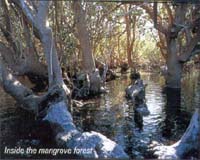 The mangrove forests along the Gulf coast
disappeared over time because the trees
were harvested. Mangrove wood was used
regularly to make beams to support the
roofs of the old forts. Most rooms in the
forts could only be 1 ˝ meter wide,
because that was the length of the beams
made from mangrove wood. When the local
mangroves had all been harvested, the wood
was imported from India and Africa.
The mangrove forests along the Gulf coast
disappeared over time because the trees
were harvested. Mangrove wood was used
regularly to make beams to support the
roofs of the old forts. Most rooms in the
forts could only be 1 ˝ meter wide,
because that was the length of the beams
made from mangrove wood. When the local
mangroves had all been harvested, the wood
was imported from India and Africa.
Now only the most southern tip of the
UAE’s Indian Ocean coastline ends in an
extensive mangrove marsh.
Khor Kalba is the oldest mangrove
forest of this part of Arabia, stretching
seven kilometers along two branches of a
tidal creek. Trees with huge trunks have
grown to a height of up to eight meters
there. The dark green belt of almost
impenetrable ancient mangroves contrasts
strongly with the brown and purple rocky
mountains and the sparkling blue water.
Young seedlings surrounded by air roots
signal a healthy environment. The mud at
low tide reveals thousands of pretty
crabs, while in the shady canopy of the
trees a unique small bird makes its home.
The Kalba White-collared kingfisher is
breeding resident here, nesting in natural
holes in mangrove trunks and branches.
This sub-species of the widespread
White-collared kingfisher is named after
Kalba: Halcyon chloris kalbaensis. Some 55 pairs have their nests in these
mangroves and they don’t occur anywhere
else in the world. They live mainly off
the crabs that burrow in the mud, although
insects also serve as food. The
kingfishers have beautiful bright blue
plumage and can be seen at dawn and dusk
streaking like brilliant jewels over the
mudflats in search of food.
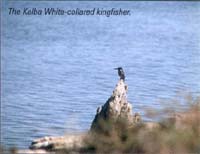
Another bird is quite unique here: the
Booted warbler (Hippolais
calligata) breeds there where the
mangroves are small and bushy, because
they have been browsed by camels. It is
the only known breeding site in the UAE
for this tiny bird, with more breeding
sites along the Batinah coast in Oman.
Both birds are in danger of extinction,
because of the deterioration of their
nesting site; the mangroves at Khor Kalba
are suffering greatly from human
intrusion.
Mangroves are important to marine ecology;
small fishes and crustaceans find the
protection they need to grow to adult size
among the roots of the salt tolerant
trees. Because mangroves grow in soft mud
they have evolved an interesting way of
reaching the air, which they need for
their metabolism. Special air-breathing
roots, called pneumatophores,
grow vertically up out of the mud so that
their tips are exposed at low tide. At
high tide the seawater covers them and the
space between the roots becomes a
playground for all sorts of small fry. The
Ministry of Agriculture and Fisheries has 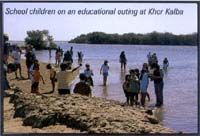 taught
the fishermen of Kalba that mangroves and
coral reefs are important to their success
as fishermen. The small fry of today will
be the large fish of tomorrow. But
there are others – mainly people who do
not make their living from fishing – who
have targeted the crabs of Khor Kalba as a
delicacy. Every weekend a drove of Asian
expatriates wade into the waters and
through the mud in search of crabs. All
the large crabs have been taken out
already. A friend, who used to come here
35 years ago as a young boy, told me that
at that time you could not cross the creek
on foot for fear of being “bitten” by
he crabs. The crabs we see nowadays are
only 3 to 5 cm in size – really big ones
are extremely rare. Because the crabs are
the main and preferred source of food for
the kingfishers, this over-catching of
crabs is very dangerous for the continued
existence of the rare bird-species. There
are half a dozen or more species of crabs
living in the mud of the creek. Some of
these have not even been properly
identified. The municipality has put up
large signs, forbidding entry into the
mangroves and the killing of any wildlife,
but without guards or game wardens to
enforce the message, this falls on deaf
ears. taught
the fishermen of Kalba that mangroves and
coral reefs are important to their success
as fishermen. The small fry of today will
be the large fish of tomorrow. But
there are others – mainly people who do
not make their living from fishing – who
have targeted the crabs of Khor Kalba as a
delicacy. Every weekend a drove of Asian
expatriates wade into the waters and
through the mud in search of crabs. All
the large crabs have been taken out
already. A friend, who used to come here
35 years ago as a young boy, told me that
at that time you could not cross the creek
on foot for fear of being “bitten” by
he crabs. The crabs we see nowadays are
only 3 to 5 cm in size – really big ones
are extremely rare. Because the crabs are
the main and preferred source of food for
the kingfishers, this over-catching of
crabs is very dangerous for the continued
existence of the rare bird-species. There
are half a dozen or more species of crabs
living in the mud of the creek. Some of
these have not even been properly
identified. The municipality has put up
large signs, forbidding entry into the
mangroves and the killing of any wildlife,
but without guards or game wardens to
enforce the message, this falls on deaf
ears.
Not only the crabs are suffering, there
are other intrusions too. Mangroves thrive
where a tidal creek is partly supplied
with fresh water from mountain run-offs. A
large section of the Khor Kalba mangrove
forest died a few years ago when a new
road was constructed around the back,
which cut off the wadis that used to empty
out into the creek. Even though this fresh
water supply occurred only a few times per
year it was sufficient to keep the
mangroves healthy.
Another danger is the way in which local
fishermen are hauling their nets these
days. The tidal creek and the
mangroves that line it are protected from
the force of the sea by wide sand spit
that extends along the whole length of the
forest from Khor Kalba harbour to the
Omani border. Over the past decade the
nets that were put out to sea are no
longer hauled in by hand. Nowadays 4WD
vehicles and pickups pull the nets ashore
by driving back and forth across the sand
spit. When the lines are very long and the
cars are not fitted out with winches, they
just back into the mangroves, destroying
the trees and their air-roots. The
vegetation on the sand spit that used to
be quite substantial has completely
disappeared, leaving the sandbar
vulnerable to erosion by the wind. In due
time the soil will no longer be held
together by the roots of plants and bushes
and one day a fierce storm will make a
breach and flood the area lying behind the
sand spit. And that will be the end of
much of the mangrove forest.
The sand spit used to be the site for a
few rather rare plants. One – a
procumbent Caralluma species, has not been seen since the late 1970’, when
the professor of botany of the UAE
University last photographed it.
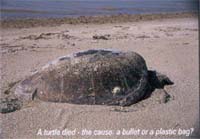 Another
called Limeum obovatum was last seen, sampled and photographed in 1984.
This latter species does occur (rarely) in
other parts of the UAE, but for the Caralluma
this was the only known site.
The tidal creek and the beaches of Khor
Kalba have long been visited by turtles,
mainly the Green turtle Chelonia
midas. But the nests that used to dot
the shore have been robbed by both, human
and animal predators, and the
day-and-night activity on the beach
disturbs the turtles so much that they
will not return to lay eggs. Turtles
swimming in the creek have mistaken blue
plastic bags for their favourite
food - jellyfish - and died a horrible
death from obstructed intestines. Another
called Limeum obovatum was last seen, sampled and photographed in 1984.
This latter species does occur (rarely) in
other parts of the UAE, but for the Caralluma
this was the only known site.
The tidal creek and the beaches of Khor
Kalba have long been visited by turtles,
mainly the Green turtle Chelonia
midas. But the nests that used to dot
the shore have been robbed by both, human
and animal predators, and the
day-and-night activity on the beach
disturbs the turtles so much that they
will not return to lay eggs. Turtles
swimming in the creek have mistaken blue
plastic bags for their favourite
food - jellyfish - and died a horrible
death from obstructed intestines.
Not long ago one of the local newspapers
featured an article on Khor Kalba with a
picture of local young men using the birds
and turtles of Khor Kalba for target
practice! Many people were outraged, but
nothing is done to protect the unique
wildlife of this small spot of paradise.
Bulldozers continue to remove sand from
the small dunes at the north end of the
sand spit, thereby reducing the landmass
and increasing the danger of erosion.
There are even plans to develop the small harbour of
Khor Kalba for commercial purposes. This
could be the final death knell for the
site as an area of natural beauty. Oil
washed out of bilges will pollute the
water as well as sewage dumped from boats.
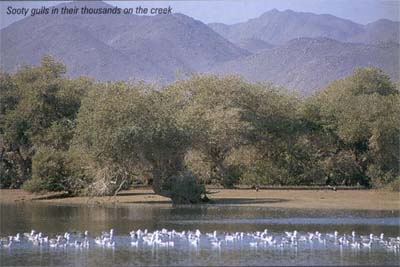
The beach along the sand spit is an
important birding site also. The activity
of the fishermen has enticed many species
of gulls to visit to feed on the scraps
left by the fishermen. One of the
world’s largest congregations of Sooty
Gulls (Larus
hemprichii) can be seen along this
beach each year, when 3 % of the world (!)
population of these birds takes up
residence in April and March. The tidal
creek is a favourite
stopover site for migrating birds. Herons
and other waders such as Greenshanks,
Whimbrels and Spoonbills feed along the
edges of the mangroves, Blue-cheeked
bee-eaters spend some time in the trees
and raptors circle above in search of
prey.
The site has become famous to
bird-watchers worldwide. It is not the
bird-watchers that are destroying the
site. They know that their chance to
practice their hobby would disappear if
they behaved in a way that would endanger
or disturb the birds and their food
source. Picnickers
leave their rubbish, which is polluting
the creek. More adventurous visitors enter
the forest and disturb the breeding birds,
while at the same time destroying fragile
young plants. At clean-ups, organised by
the Arabian Leopard Trust and the Desert
Rangers, tons of rubbish was collected
from the sand spit and from inside the
forest.
Khor Kalba has the potential to become a
famous and favourite tourist site and not
much is needed to protect it. A guarded
gate on the bridge would keep out
unsupervised people. The picnic site and
playground could be moved to the West Side
of the bridge.
The unused fish factory and the small
building that was once respectively used
for a study project could be converted
respectively into an aquarium and an
education centre.
Guided tours of small groups of tourists
into the mangroves could raise public
awareness and reduce the impact of
visitors, without making the whole place
off-limits. If the nightly disturbances on
the beach were completely prevented, the
turtles would come back to lay their eggs.
It takes 30 years for a female turtle to
reach maturity and she will return to the
beach of her birth to lay her eggs! Thirty
years ago Khor Kalba was a place of serene
beauty and the turtle will not know how
much has changed since then. If she comes
now, the lights of cars and fires of
campers will put her off her business of
egg laying. She will find another beach
somewhere else. It would be a great
feather in the cap of UAE efforts for
nature conservation if the turtles would
build their nests again on the East Coast.
The
success of Oman’s turtle coast as a
tourist attraction could be equaled here,
provided there was proper management of
the site.
According
to RAMSAR criteria Khor Kalba qualifies
for protection because
1.
it is a particularly good
representative example of a natural or
near-natural wetland, characteristic of
the appropriate bio-geographical region.
2.
it is of special value for
maintaining the genetic and ecological
diversity of a region because of the
quality and peculiarities of its flora and
fauna.
3.
it regularly supports 1% of the
individuals in a population of one species
or subspecies of waterfowl.
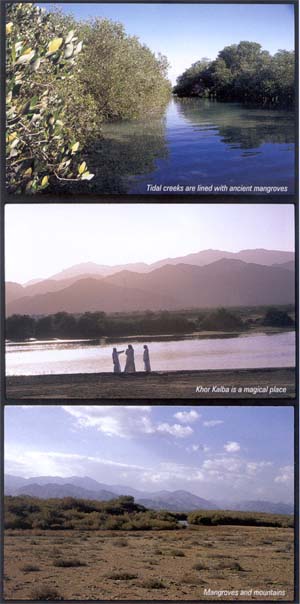
On
December 18th, 1996 Khaleej
Times reported:
“The
go-ahead has been given for the
establishment of the UAE’s first
national park and nature reserve at Khor
Kalba in the emirate of Sharjah. His
Highness,
Dr. Sheikh Sultan bin Mohammed al
Qasimi, Member of the Supreme Council and
Ruler of Sharjah, has approved the
management plan for the creation and
operation of the park and reserve, whose
purpose will be to conserve and nurture
the rare flora and fauna of the area as a
national treasure while strictly
regulating public access to it.”
This
decision was widely acclaimed by nature
lovers in the Emirates and bird lovers all
around the world. Unfortunately, the
decision has not been followed up by
action and the vulnerable mangrove forest
and tidal creek of Khor Kalba are still
being destroyed on a daily basis five
years later.
Khor
Kalba is a magical place, a place of
exquisite beauty. Khor Kalba needs a
campaign, supported by all of us, to
ensure its protection
|
